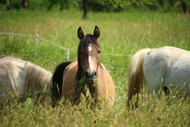Your Horse’s Pasture and Mineral Imbalances: Part One
Posted by Placide on 14th Aug 2017
Sodium, potassium, calcium and magnesium are essential minerals in your horse’s diet. However, in New Zealand, our ever-changing climate can create mineral imbalances in your horse’s pasture, most notably in Autumn and Spring.
In our new series, we examine each of these minerals to highlight their importance in your horse’s diet and minimise potential health problems.
For many horse owners, what appears at first glance to be healthy, nutritious pasture, suitable for horses, is actually numerous grass and legume species that are deficient in some minerals and overloaded with others, leading to harmful health consequences.
Unless your pasture is organically farmed and completely free of fertilisers, your pasture will be imbalanced. Most often, Spring and Autumn grasses are high in potassium and low in sodium, and many New Zealand pastures are simply deficient in calcium and magnesium.
Let’s start with sodium…
Stressed Grass and Sodium
In New Zealand, the conditions of early Autumn and Spring lead to an accumulation of potassium and nitrogen in your pasture, particularly following rain, cold and wet weather, or frost. In turn, sodium levels drop; a mineral imbalance further worsened with the use of nitrogenous fertilisers.
The first step - discontinuing the use of such fertilisers is obvious - but there’s more you can do:
- Test your pasture - It’s important to know which grass and legume species are present in your pasture, so you can take steps to introduce desirable species.
- Supplement sodium - Oxalate grasses, such as Kikuyu, bind sodium, reducing your horse’s ability to absorb it. If adding salt to feed, 10g per 100kg of bodyweight is a good starting point.
Spring Grass and Sodium
In addition, spring grass growth is perhaps notorious for the many associated health problems that can arise alongside it. Applying salt to your horse’s pasture in either late Winter or early Spring will also help to reduce the effects of high potassium and nitrogen.
Sodium Loss in Spring
Finally, sodium is an important electrolyte, which must be replaced if lost. Sodium is often loss via sweat, but for those mares in their third trimester, sodium is also vital. Fine, non-iodised salt can be easily purchased from your local produce store. You may also consider:
- An electrolyte replacer - Particularly following high intensity exercise on warm Spring and Summer days.
- A salt lick - Hang it low in your horse’s stall or paddock. Sodium is a mineral that your horse will seek out if they’re deficient.
Placide is the number one equine calming supplement in New Zealand. Containing organic, chelated magnesium, Placide works to relax muscles, reduce stress and support your horse’s health for improved performance in less than one week. Click here to find out more.
Disclaimer: This article is not intended as veterinary advice. At Placide, we encourage you to make health care decisions for your horse based on your own research and in partnership with a qualified veterinarian.

